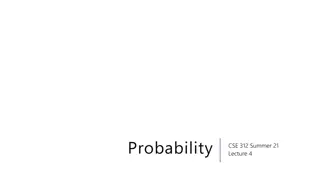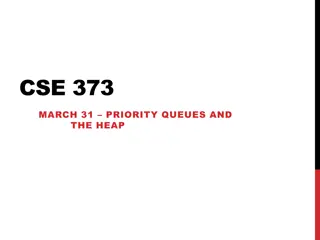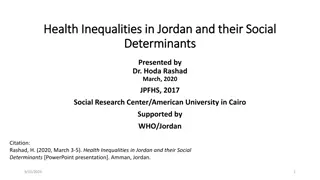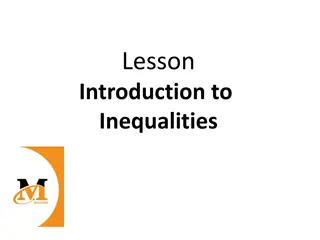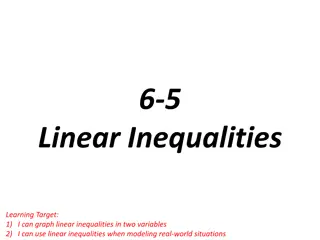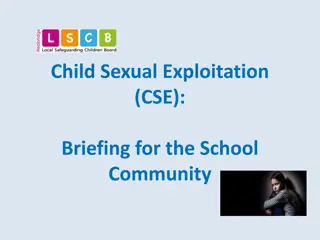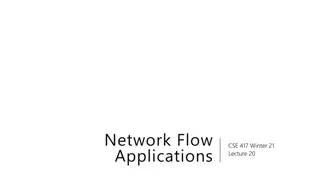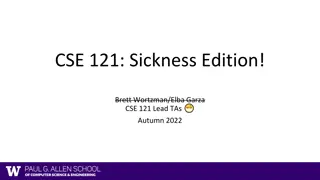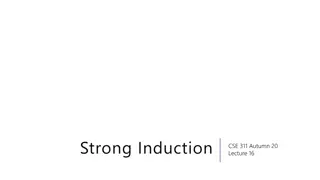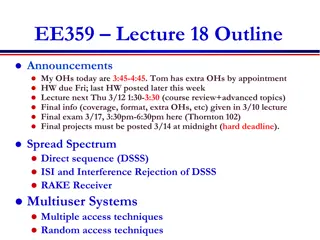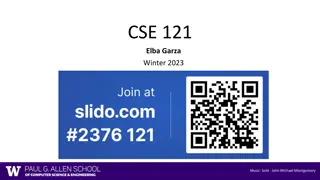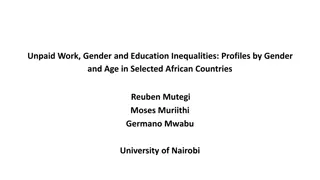Important Updates and Inequalities in CSE.312 Summer 21 Lecture
Announcements include changes in deadlines, release of final logistics, and upcoming interviews. Markov's Inequality and Chebyshev's Inequality are discussed with practical applications like bounding distribution tails and polling probabilities. The content covers concepts of variance, probability calculations, and repeated experiments.
Download Presentation

Please find below an Image/Link to download the presentation.
The content on the website is provided AS IS for your information and personal use only. It may not be sold, licensed, or shared on other websites without obtaining consent from the author. Download presentation by click this link. If you encounter any issues during the download, it is possible that the publisher has removed the file from their server.
E N D
Presentation Transcript
Tail Bounds Continued CSE 312 Summer 21 Lecture 20
Announcements Problem Set 7 is due on Monday, Aug 16 and not Thursday, Aug 12 Deadlines to be aware of: Real World 2 Wednesday, Aug 11 Review Summary 3 Friday, Aug 13 Problem Set 7 Monday, Aug 16
Final Logistics Will be released on Friday evening, Aug 13 Timed 2 hours NO PROCTORS except yourself! The key will be released on Tuesday, Aug 17, at midnight Interviews conducted Wednesday Friday of the final week Submit your attempt on Gradescope before the interview
Markovs Inequality Two statements are equivalent. Left form is often easier to use. Right form is more intuitive. Markov s Inequality Markov s Inequality Let ? be a random variable supported (only) on non-negative numbers. For any ? > ? ? ? ?[?] Let ? be a random variable supported (only) on non-negative numbers. For any ? > ? ? ??[?] ? ? ? To apply this bound you only need to know: 1. it s non-negative 2. Its expectation.
Sowhat do we do? A better inequality! We re trying to bound the tails of the distribution. What parameter of a random variable describes the tails? The variance!
Chebyshevs Inequality Two statements are equivalent. Left form is often easier to use. Right form is more intuitive. Chebyshev s Inequality Chebyshev s Inequality Let ? be a random variable. For any ? > ? ? ???(?) Let ? be a random variable. For any ? > ? ? ?? ? ? ? ? ??? ? ? ? ? ??
Near the mean Suppose you run a poll of 1000 people where in the true population 60% of the population supports you. What is the probability that the poll is not within 10-percentage-points of the true value? ?? 1000 ? = Chebyshev s Inequality 0.6 1000=3 ? ? = 1000 5 Let ? be a random variable. For any ? > ? ? ???(?) Var ? = 1000 0.6 0.4 3 10002= 0.1 3/12500 12500 0.12= 0.024 ? ? ? ? ? ? ??
Chebyshevs Repeated Experiments How many coin flips (each head with probability ?) are needed until you get ? heads? Let ? be the number necessary. What is probability ? 2? ?? Markov Chebyshev
Chebyshevs Repeated Experiments How many coin flips (each head with probability ?) are needed until you get ? heads? Let ? be the number necessary. What is probability ? 2? ?? ? 2? ?/? 2?/?=1 Markov ? 2 ?2/?2=?(1 ?)/?2 ? 2? ? ? ? ? Var(?) =1 ? Chebyshev ?2/?2 ? ? ?
Takeaway Chebyshev gets more powerful as the variance shrinks. Repeated experiments are a great way to cause that to happen.
More Assumptions Better Guarantee (Multiplicative) Chernoff Bound Let ?1,?2, ,?? be independent Bernoulli random variables. Let ? = ??, and ? = ? ? . For any 0 ? 1 ? 1 + ? ? exp ?2? and ? 1 ? ? exp ?2? 3 2
Same Problem, New Solution Suppose you run a poll of 1000 people where in the true population 60% of the population supports you. What is the probability that the poll is not within 10-percentage-points of the true value? (Multiplicative) Chernoff Bound Let ?1,?2, ,?? be independent Bernoulli random variables. Let ? = ??, and ? = ? ? . For any 0 ? 1 ? 1 + ? ? exp ?2? and ? 1 ? ? exp ?2? 3 2
Right Tail Suppose you run a poll of 1000 people where in the true population 60% of the population supports you. What is the probability that the poll is not within 10-percentage-points of the true value? Want 1000 0.7 = (? 0.7 1000) = ? 1 +0.1 0.6 (0.6 1000) So ? =1 ? Chernoff Bound (right tail) Let ?1,?2, ,?? be independent Bernoulli random variables. Let ? = ??, and ? = ? ? . For any 0 ? 1 ? 1 + ? ? exp ?2? 6 and ? = 0.6 1000 1 62 0.6 1000 3 ? 700 exp 0.0039 3
Left Tail Suppose you run a poll of 1000 people where in the true population 60% of the population supports you. What is the probability that the poll is not within 10-percentage-points of the true value? Chernoff Bound (left tail) Let ?1,?2, ,?? be independent Bernoulli random variables. Let ? = ??, and ? = ? ? . For any 0 ? 1 ? 1 ? ? exp ?2? Fill out the poll everywhere so Kushal knows how long to explain Go to pollev.com/cse312su21 2
Left Tail Suppose you run a poll of 1000 people where in the true population 60% of the population supports you. What is the probability that the poll is not within 10-percentage-points of the true value? Want 1000 0.5 = (? 0.5 1000) = ? 1 0.1 0.6 (0.6 1000) So ? =1 ? Chernoff Bound (left tail) Let ?1,?2, ,?? be independent Bernoulli random variables. Let ? = ??, and ? = ? ? . For any 0 ? 1 ? 1 ? ? exp ?2? 6 and ? = 0.6 1000 1 62 0.6 1000 2 ? 500 exp 0.0003 2
Both Tails Let ? be the event that ?is not between 500 and 700 (i.e., we re not within 10 percentage points of the true value) ? = ? < 500 + ? > 700 0.0039 + 0.0003 = 0.0042 Less than 1%. That s a better bound than Chebyshev gave!
Wait a Minute I asked Wikipedia about the Chernoff Bound and I saw something different? This is the easiest to use version of the bound. If you need something more precise, there are other versions. Why are the tails different?? The strongest/original versions of Chernoff bounds are symmetric (1 + ? and 1 ? correspond), but those bounds are ugly and hard to use. When computer scientists made the easy to use versions , they needed to use some inequalities. The numerators now have plain old ? s, instead of 1 + or 1 . As part of the simplification to this version, there were different inequalities used so you don t get exactly the same expression.
Wait a Minute This is just a binomial! The concentration inequality will let you control ? easily, even as a variable. That s not easy with the binomial. What happens when ? gets big? Evaluating 20000 floating point error and other issues. Chernoff is much better. 10000 0.5110000 0.4910000is fraught with chances for
But Wait! Theres More For this class, please limit yourself to: Markov, Chebyshev, and Chernoff, as stated in these slides But for your information. There s more. Trying to apply Chebyshev, but only want a one-sided bound (and tired of losing that almost-factor-of-two)Try Cantelli s Inequality In a position to use Chernoff, but want additive distance to the mean instead of multiplicative? They got one of those. Have a sum of independent random variables that aren t indicators, but are bounded, you better believe Wikipedia s got one Have a sum of random matrices matrices instead of a sum of random numbers. Not only is that a thing you can do, but the eigenvalue of the matrix concentrates
Markovs Inequality Chebyshev s Inequality Let ? be a random variable supported (only) on non-negative numbers. For any ? > ? ? ? ?[?] Let ? be a random variable. For any ? > ? ? ???(?) ? ? ? ?? ? (Multiplicative) Chernoff Bound Let ?1,?2, ,?? be independent Bernoulli random variables. Let ? = ??, and ? = ? ? . For any 0 ? 1 ? 1 + ? ? exp ?2? and ? 1 ? ? exp ?2? 3 2
One More Bound Union Bound For any events ?,? ? ? ? + (?) Proof? ? ? = ? + ? (? ?) And ? ? 0.
Concentration Applications A common pattern: Figure out what could possibly go wrong often these are dependent. Use a concentration inequality for each of the things that could go wrong. Union bound over everything that could go wrong.
Frogs There are 20 frogs on each location in a 5x5 grid. Each frog will independently jump to the left, right, up, down, or stay where it is with equal probability. A frog at an edge of the grid magically warps to the corresponding edge (Pac-Man style). Bound the probability that at least one square ends up with at least 36 frogs. These events are dependent adjacent squares affect each other!
Frogs For an arbitrary location: There are 100 frogs who could end up there (those above, below, left, right, and at that location). Each with probability 0.2. Let ? be the number that land at the location we re interested in. 2 20 4 5 ? 36 = ? 1 + ? 20 exp 0.015 3 There are 25 locations. Since all locations are symmetric, by the union bound the probability of at least one location having 36 or more frogs is at most 25 0.015 0.375.
Tail Bounds Takeaways Useful when an experiment is complicated, and you just need the probability to be small (you don t need the exact value). Choosing a minimum ? for a poll don t need exact probability of failure, just to make sure it s small. Designing probabilistic algorithms just need a guarantee that they ll be extremely accurate Learning more about the situation (e.g., learning variance instead of just mean, knowing bounds on the support of the starting variables) usually lets you get more accurate bounds.





